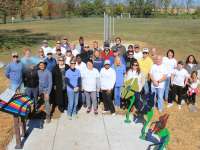Integrating plants with manufactured equipment isa primary playground naturalization strategy. A broad range of possibilities are possible with a variety of plants such as deciduous and evergreen trees, deciduous and evergreen shrubs, vines, and ground covers of various growth habits and sizes. Flowering perennials add a compelling variety of colors, textures, and fragrances to the plant palette.
NatureGrounds®: Designing Play Environments that Integrate Manufactured Play Equipment with the Living Landscape is a complete resource for planning your next space. Here we've selected some key principles when selecting plants for the playground to help get you started.
Preserve, select, and integrate trees and other plants in the playground site
Preserve existing trees
- Use a qualified arborist to carefully examine existing trees for disease before a playground is installed, to ensure that existing trees are worth preserving. If a tree is judged to be seriously diseased or near the end of its life, it may make sense to replace it with a new, carefully selected, large caliper specimen tree.
- Locate playground equipment beyond the drip line of existing trees to avoid damage to tree roots, preferably on the north side to provide shade. Protect tree trunk flare area and limit disturbance of tree roots within the area under the tree canopy drip line.
- Install a tree protection fence as required by local regulations, if appropriate.
- Take advantage, where possible, of existing trees on a playground to add a sense of identity to the site. At the same time, be sure to honor the manufacturer’s suggested use zones when incorporating trees into naturalized play areas.
Select child-friendly, high play value plants
Consider the following play and learning criteria when selecting plants for children’s play areas:
- Contrasting leaf textures for sensory stimulation: evergreen with deciduous, shiny with rough, serrated with smooth edges, thin with thick.
- Variety of sizes and shapes of plants.
- Seasonal change for novelty and interest: evergreen contrasted with deciduous, seasonal color, early leaves, late flowers, etc.
- Color variety of trees, shrubs, vines, ground covers, and flowering perennials.
- Fragrance for sensory stimulation and exploration.
- Natural elements like berries and cones that can be used for craft activities.
- Auditory stimulation. Some plants, especially in the fall, produce interesting sounds when thewind blows through their dry leaves. Plants such as clumping bamboo and pine trees produce sounds year-round.
Consider plants as design elements in naturalized playground design to perform the following functions:
- Enclosure. The size, shape, and enclosure of play spaces can be enhanced by being wholly orpartially defined with plants.
- Shade. Deciduous trees offer summer shade and let winter warmth through when leafless.Evergreen trees and shrubs add green interest during the dormant season of deciduous trees.
- Identity. Distinctive plantings provide visual identity and a sense of place to children’s environments.
- Movement. Using plants in relation to topography can enhance the experience of movement through play areas. Grasses in particular add an element of movement.
- Play props. Vegetation supplies a wide variety of play resources or loose parts that children can harvest for themselves and/or their friends.
- Sensory stimulation. Plants can be selected to provide a full range of sensory experiences.
- Accessibility/inclusion. Plant settings can create intimate, touchable spaces that are accessible to users of all abilities and therefore offer particular advantages as inclusive settings.
- Landmarks. Objects such as specimen trees offer visual identity and function as landmarks.
- Seasonal change and novelty. Plants mark the passing of seasons and introduce children to a sense of time and natural processes as plants grow and change.
- Wildlife enhancement. Plants provide animal habitats so that children can interact with wildlife in play areas.
Compile site specific plant lists
- Use the Play Value Plant Database searchable plant selection tool to get started.
- The plant list should include the genus, species, size, quantity, quality, and variety of plants to be used for ease of identification by the supplier.
Select healthy, appropriate plants
- Choose drought-tolerant, deer-resistant plants that are hardy in the playground site hardiness zone for your region. Refer to the USDA Hardiness Map.
- Choose native species if possible or species that are adapted to the region and have an established reputation for hardiness.
- Avoid invasive species introduced from other geographic areas, to prevent aggressive competition with native species.
- Choose plants with healthy, full, well-shaped root systems.
- Choose fully branched plants with evidence of vigorous growth and dense foliage.



